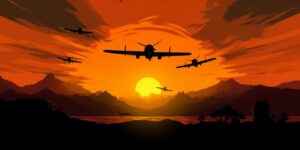One way to classify aircraft is based on their category. The two primary categories are fixed-wing and rotary-wing. Fixed-wing aircraft, such as airplanes, derive lift from their wings’ shape, while rotary-wing aircraft, like helicopters, generate lift through rotating blades.
Further classifying aircraft involves considering their class, which takes into account their intended purpose. Among the common classes are commercial, military, general aviation, and experimental. Each class serves distinct roles, with commercial aircraft catering to passenger transport, military planes designed for defense purposes, general aviation encompassing private and recreational flying, and experimental covering innovative prototypes and designs.
Now, let’s delve into the various types of aircraft within these categories and classes. In the fixed-wing category, we encounter subtypes like airplanes, gliders, and ultralights. Airplanes further branch into single-engine, twin-engine, and jet aircraft, each with its unique characteristics and applications.
Helicopters take the spotlight in the rotary-wing category. These versatile aircraft are employed in military operations, emergency medical services, and aerial reconnaissance. Their ability to hover and take off vertically sets them apart from fixed-wing counterparts.
When it comes to military aircraft, they exhibit diverse functionalities. Fighter jets, bombers, transport planes, and reconnaissance aircraft fall under this class. The types of military aircraft are often defined by their primary mission and capabilities, such as air superiority, strategic bombing, or surveillance.
General aviation includes a broad range of aircraft used for personal and business purposes. These encompass small single-engine planes, private jets, and recreational aircraft. Pilots engaging in general aviation enjoy the flexibility of flying for leisure or transportation without the constraints of commercial schedules.
Lastly, the experimental class accommodates innovative and unconventional aircraft. These prototypes may not conform to traditional designs and are often subject to testing and development. Experimental aircraft contribute to advancements in aviation technology and design.
Passenger aircraft classification by engine and category
Passenger aircraft are classified based on various factors, with the type of engine and category being crucial in determining their characteristics and applications. The turbofan engine is a common propulsion system in modern passenger aircraft, known for its efficiency and performance. It utilizes both core and fan components to generate thrust, making it suitable for a range of aircraft categories.
In terms of category, passenger aircraft can be broadly classified into narrow-body and wide-body aircraft. Narrow-body planes typically have a single aisle and are designed for shorter routes, making them ideal for domestic flights. On the other hand, wide-body aircraft feature multiple aisles, providing more seating capacity and longer range capabilities, making them suitable for international travel.
Further categorization within these broad classifications includes regional jets, single-aisle jets, and long-range wide-body jets. Regional jets are smaller aircraft designed for shorter distances, connecting smaller airports. Single-aisle jets, commonly referred to as narrow-body jets, are versatile and widely used for both short and medium-haul flights, serving as the workhorses for many airlines.
Meanwhile, long-range wide-body jets are designed to cover vast distances, connecting continents with non-stop flights. These aircraft often feature advanced technologies, larger fuel capacities, and extended ranges, catering to the demands of intercontinental travel. Examples of such aircraft include the Boeing 777 and the Airbus A350.
When looking at specific models, it’s essential to consider the distinctive features of each aircraft. For instance, the Boeing 737 is a prominent single-aisle jet known for its reliability and fuel efficiency. In contrast, the Airbus A380 stands out as a renowned wide-body jet, setting records for its passenger capacity and luxurious amenities.
As technology continues to advance, new trends in passenger aircraft design emerge. The development of electric propulsion and hybrid systems is gaining attention, aiming to make aviation more sustainable and environmentally friendly. These innovations could reshape the future classifications of passenger aircraft, introducing new categories based on propulsion technologies.
Light passenger planes categorized according to wingspan & seating capacity

When exploring the fascinating world of aviation, one encounters a diverse array of light passenger planes designed to cater to specific needs. These aircraft are ingeniously categorized according to their wingspan and seating capacity, offering a spectrum of options for both enthusiasts and practical commuters alike.
One noteworthy category in this domain is the realm of short-range commuter light aircraft. These agile planes are tailored for quick and efficient travel over relatively brief distances, making them ideal for regional connectivity. The emphasis on short-range journeys reflects the changing landscape of modern transportation needs.
Among the distinctive types within this category, the high-wing single-engine configuration stands out. The high-wing design, characterized by the placement of the wings on the top of the fuselage, provides several advantages. Enhanced visibility, simpler ground operations, and improved stability during flight are key features that make high-wing single-engine planes a popular choice in the world of light aviation.
Stepping into the cabin class of these aircraft unveils a world of comfort and sophistication. Despite their compact size, cabin-class light planes prioritize passenger experience, offering well-designed interiors that maximize space. The utilization of advanced materials and ergonomic design principles contributes to a cozy and enjoyable journey for those on board.
Transitioning further, we encounter a fascinating breed of light planes that blur the line between private and commercial aviation—the small airliner turboprop. This subset combines the efficiency of a turboprop engine with a compact size suitable for smaller airports. The result is a versatile aircraft capable of serving routes that larger counterparts may find challenging.
As we navigate through the intricacies of these light passenger planes, it becomes evident that they represent more than just modes of transportation. They embody innovation, adaptability, and a commitment to meeting the evolving demands of air travel. The synthesis of short-range commuter capabilities, high-wing configurations, single-engine prowess, cabin class comfort, and small airliner turboprop efficiency paints a vivid picture of the dynamic landscape in which these aircraft thrive.
Historical evolution of aircraft designs through decades of aviation history
Exploring the captivating historical evolution of aircraft designs unveils a mesmerizing journey through the decades of aviation history. From the early days of flight characterized by primitive biplanes to the sleek and advanced monoplanes of modern times, the transformation is nothing short of extraordinary.
Beginning in the early 20th century, biplanes dominated the skies. These dual-winged wonders, often constructed with wooden frames and fabric-covered wings, showcased a distinctive design that provided stability in the air. The open cockpit was a defining feature, allowing pilots to experience the thrill of flight in its purest form.
As aviation technology progressed, the spotlight shifted to monoplanes. These single-winged marvels represented a departure from the traditional biplane structure, offering improved aerodynamics and speed. The transition marked a significant milestone in the pursuit of efficiency and performance.
Amidst this evolution, the aviation landscape witnessed the emergence of experimental aircraft. These cutting-edge creations pushed the boundaries of conventional design, exploring unconventional shapes and configurations. The experimental realm became a breeding ground for innovation, birthing ideas that would shape the future of aviation.
Delving into the annals of aviation history also unveils a treasure trove of vintage aircraft. These timeless machines, with their nostalgic charm, serve as a testament to the craftsmanship of a bygone era. The allure of a radial engine humming in the background and the sensation of wind against a fabric-covered fuselage evoke a sense of romance that transcends time.
One cannot overlook the intrigue of open cockpit aircraft. The exposed cockpit, characteristic of early aviation, symbolizes the daring spirit of those intrepid pilots who took to the skies with nothing but the wind and clouds as companions. The open cockpit design, while a thing of the past in mainstream aviation, remains an enduring symbol of the pioneer aviators.
Highlighting the technological milestones, the era of radial engines played a pivotal role. The distinctive circular arrangement of cylinders in a radial engine provided efficient cooling and power, contributing to the success of numerous iconic aircraft. This engineering marvel left an indelible mark on the aviation landscape.
Intricately weaving together the threads of biplane monoplane experimental aircraft vintage open cockpit radial engine fabric covered, the tapestry of aviation history unfolds. Each keyword represents a crucial chapter, a facet of the perpetual innovation that defines the evolution of aircraft design.






